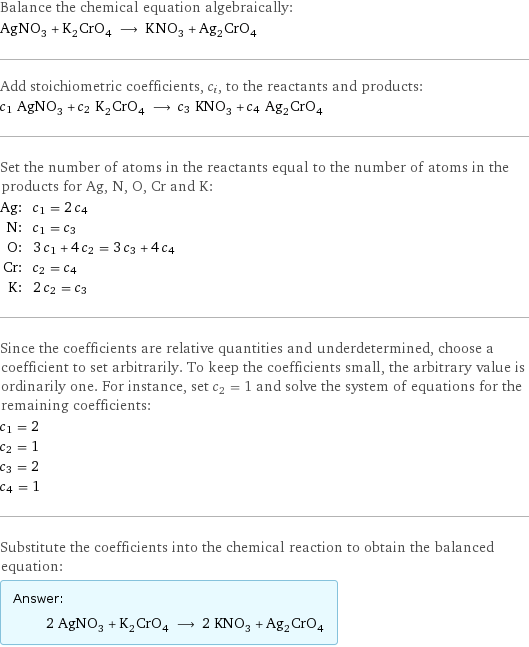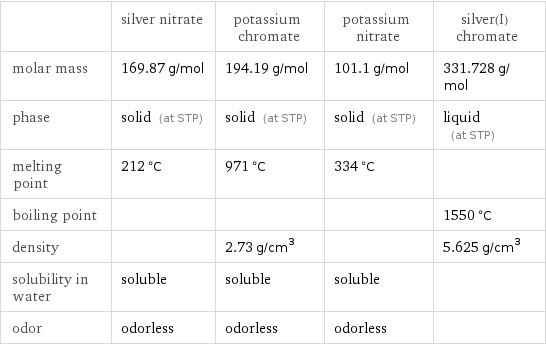Input interpretation

AgNO_3 silver nitrate + K_2CrO_4 potassium chromate ⟶ KNO_3 potassium nitrate + Ag_2CrO_4 silver(I) chromate
Balanced equation

Balance the chemical equation algebraically: AgNO_3 + K_2CrO_4 ⟶ KNO_3 + Ag_2CrO_4 Add stoichiometric coefficients, c_i, to the reactants and products: c_1 AgNO_3 + c_2 K_2CrO_4 ⟶ c_3 KNO_3 + c_4 Ag_2CrO_4 Set the number of atoms in the reactants equal to the number of atoms in the products for Ag, N, O, Cr and K: Ag: | c_1 = 2 c_4 N: | c_1 = c_3 O: | 3 c_1 + 4 c_2 = 3 c_3 + 4 c_4 Cr: | c_2 = c_4 K: | 2 c_2 = c_3 Since the coefficients are relative quantities and underdetermined, choose a coefficient to set arbitrarily. To keep the coefficients small, the arbitrary value is ordinarily one. For instance, set c_2 = 1 and solve the system of equations for the remaining coefficients: c_1 = 2 c_2 = 1 c_3 = 2 c_4 = 1 Substitute the coefficients into the chemical reaction to obtain the balanced equation: Answer: | | 2 AgNO_3 + K_2CrO_4 ⟶ 2 KNO_3 + Ag_2CrO_4
Structures

+ ⟶ +
Names

silver nitrate + potassium chromate ⟶ potassium nitrate + silver(I) chromate
Equilibrium constant
![Construct the equilibrium constant, K, expression for: AgNO_3 + K_2CrO_4 ⟶ KNO_3 + Ag_2CrO_4 Plan: • Balance the chemical equation. • Determine the stoichiometric numbers. • Assemble the activity expression for each chemical species. • Use the activity expressions to build the equilibrium constant expression. Write the balanced chemical equation: 2 AgNO_3 + K_2CrO_4 ⟶ 2 KNO_3 + Ag_2CrO_4 Assign stoichiometric numbers, ν_i, using the stoichiometric coefficients, c_i, from the balanced chemical equation in the following manner: ν_i = -c_i for reactants and ν_i = c_i for products: chemical species | c_i | ν_i AgNO_3 | 2 | -2 K_2CrO_4 | 1 | -1 KNO_3 | 2 | 2 Ag_2CrO_4 | 1 | 1 Assemble the activity expressions accounting for the state of matter and ν_i: chemical species | c_i | ν_i | activity expression AgNO_3 | 2 | -2 | ([AgNO3])^(-2) K_2CrO_4 | 1 | -1 | ([K2CrO4])^(-1) KNO_3 | 2 | 2 | ([KNO3])^2 Ag_2CrO_4 | 1 | 1 | [Ag2CrO4] The equilibrium constant symbol in the concentration basis is: K_c Mulitply the activity expressions to arrive at the K_c expression: Answer: | | K_c = ([AgNO3])^(-2) ([K2CrO4])^(-1) ([KNO3])^2 [Ag2CrO4] = (([KNO3])^2 [Ag2CrO4])/(([AgNO3])^2 [K2CrO4])](../image_source/43b91c1284e68ec211898ea505fe7354.png)
Construct the equilibrium constant, K, expression for: AgNO_3 + K_2CrO_4 ⟶ KNO_3 + Ag_2CrO_4 Plan: • Balance the chemical equation. • Determine the stoichiometric numbers. • Assemble the activity expression for each chemical species. • Use the activity expressions to build the equilibrium constant expression. Write the balanced chemical equation: 2 AgNO_3 + K_2CrO_4 ⟶ 2 KNO_3 + Ag_2CrO_4 Assign stoichiometric numbers, ν_i, using the stoichiometric coefficients, c_i, from the balanced chemical equation in the following manner: ν_i = -c_i for reactants and ν_i = c_i for products: chemical species | c_i | ν_i AgNO_3 | 2 | -2 K_2CrO_4 | 1 | -1 KNO_3 | 2 | 2 Ag_2CrO_4 | 1 | 1 Assemble the activity expressions accounting for the state of matter and ν_i: chemical species | c_i | ν_i | activity expression AgNO_3 | 2 | -2 | ([AgNO3])^(-2) K_2CrO_4 | 1 | -1 | ([K2CrO4])^(-1) KNO_3 | 2 | 2 | ([KNO3])^2 Ag_2CrO_4 | 1 | 1 | [Ag2CrO4] The equilibrium constant symbol in the concentration basis is: K_c Mulitply the activity expressions to arrive at the K_c expression: Answer: | | K_c = ([AgNO3])^(-2) ([K2CrO4])^(-1) ([KNO3])^2 [Ag2CrO4] = (([KNO3])^2 [Ag2CrO4])/(([AgNO3])^2 [K2CrO4])
Rate of reaction
![Construct the rate of reaction expression for: AgNO_3 + K_2CrO_4 ⟶ KNO_3 + Ag_2CrO_4 Plan: • Balance the chemical equation. • Determine the stoichiometric numbers. • Assemble the rate term for each chemical species. • Write the rate of reaction expression. Write the balanced chemical equation: 2 AgNO_3 + K_2CrO_4 ⟶ 2 KNO_3 + Ag_2CrO_4 Assign stoichiometric numbers, ν_i, using the stoichiometric coefficients, c_i, from the balanced chemical equation in the following manner: ν_i = -c_i for reactants and ν_i = c_i for products: chemical species | c_i | ν_i AgNO_3 | 2 | -2 K_2CrO_4 | 1 | -1 KNO_3 | 2 | 2 Ag_2CrO_4 | 1 | 1 The rate term for each chemical species, B_i, is 1/ν_i(Δ[B_i])/(Δt) where [B_i] is the amount concentration and t is time: chemical species | c_i | ν_i | rate term AgNO_3 | 2 | -2 | -1/2 (Δ[AgNO3])/(Δt) K_2CrO_4 | 1 | -1 | -(Δ[K2CrO4])/(Δt) KNO_3 | 2 | 2 | 1/2 (Δ[KNO3])/(Δt) Ag_2CrO_4 | 1 | 1 | (Δ[Ag2CrO4])/(Δt) (for infinitesimal rate of change, replace Δ with d) Set the rate terms equal to each other to arrive at the rate expression: Answer: | | rate = -1/2 (Δ[AgNO3])/(Δt) = -(Δ[K2CrO4])/(Δt) = 1/2 (Δ[KNO3])/(Δt) = (Δ[Ag2CrO4])/(Δt) (assuming constant volume and no accumulation of intermediates or side products)](../image_source/3b18204aef694cbe33b0b1a36cbf7dab.png)
Construct the rate of reaction expression for: AgNO_3 + K_2CrO_4 ⟶ KNO_3 + Ag_2CrO_4 Plan: • Balance the chemical equation. • Determine the stoichiometric numbers. • Assemble the rate term for each chemical species. • Write the rate of reaction expression. Write the balanced chemical equation: 2 AgNO_3 + K_2CrO_4 ⟶ 2 KNO_3 + Ag_2CrO_4 Assign stoichiometric numbers, ν_i, using the stoichiometric coefficients, c_i, from the balanced chemical equation in the following manner: ν_i = -c_i for reactants and ν_i = c_i for products: chemical species | c_i | ν_i AgNO_3 | 2 | -2 K_2CrO_4 | 1 | -1 KNO_3 | 2 | 2 Ag_2CrO_4 | 1 | 1 The rate term for each chemical species, B_i, is 1/ν_i(Δ[B_i])/(Δt) where [B_i] is the amount concentration and t is time: chemical species | c_i | ν_i | rate term AgNO_3 | 2 | -2 | -1/2 (Δ[AgNO3])/(Δt) K_2CrO_4 | 1 | -1 | -(Δ[K2CrO4])/(Δt) KNO_3 | 2 | 2 | 1/2 (Δ[KNO3])/(Δt) Ag_2CrO_4 | 1 | 1 | (Δ[Ag2CrO4])/(Δt) (for infinitesimal rate of change, replace Δ with d) Set the rate terms equal to each other to arrive at the rate expression: Answer: | | rate = -1/2 (Δ[AgNO3])/(Δt) = -(Δ[K2CrO4])/(Δt) = 1/2 (Δ[KNO3])/(Δt) = (Δ[Ag2CrO4])/(Δt) (assuming constant volume and no accumulation of intermediates or side products)
Chemical names and formulas

| silver nitrate | potassium chromate | potassium nitrate | silver(I) chromate formula | AgNO_3 | K_2CrO_4 | KNO_3 | Ag_2CrO_4 Hill formula | AgNO_3 | CrK_2O_4 | KNO_3 | Ag_2CrO_4 name | silver nitrate | potassium chromate | potassium nitrate | silver(I) chromate IUPAC name | silver nitrate | dipotassium dioxido-dioxochromium | potassium nitrate | disilver dioxido(dioxo)chromium
Substance properties

| silver nitrate | potassium chromate | potassium nitrate | silver(I) chromate molar mass | 169.87 g/mol | 194.19 g/mol | 101.1 g/mol | 331.728 g/mol phase | solid (at STP) | solid (at STP) | solid (at STP) | liquid (at STP) melting point | 212 °C | 971 °C | 334 °C | boiling point | | | | 1550 °C density | | 2.73 g/cm^3 | | 5.625 g/cm^3 solubility in water | soluble | soluble | soluble | odor | odorless | odorless | odorless |
Units
